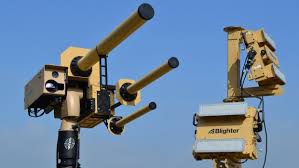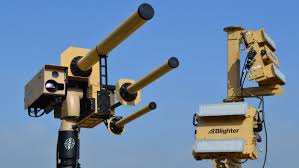
A “death ray” for drones in the UK can now knock an unmanned aerial vehicle out of the sky by turning it off in midair up to a mile away. The ray has been developed by a team of British technology firm.
“If I can see it, I can kill it,” said Rick Sondag, executive vice-president of Liteye Systems, which displayed the device for sale at the Commercial Unmanned Aerial Vehicle (UAV) Expo in Las Vegas this week.
As unmanned aerial vehicles have taken off, so has the interest in drone-killers. While the government applications and law enforcement utilities could be of mass use, the utility of drone killer rays might be readily apparent to people who have seen hobbyist drone fliers buzzing too close to their property lines.
A prison recreation yard was the target of a drone that dropped off heroin, marijuana and tobacco in July this year in the US. Another contraband delivery drone allegedly on its way to a prison was nabbed by cops before it got off the ground in Maryland the following month. Local law enforcement said it was not the first time they had dealt with the problem after the second incident happened.
The ongoing trouble with curious drone photographers trying to get pictures of natural disasters, especially where fire department helicopters are trying to unload payloads of water or airlift out stranded victims as well as the issues related to safety of airports.
A set of beige boxes atop two square posts comprises Liteye’s Anti-UAV Defense System (Auds). The gadget looks like a particularly menacing pair of weather vanes. A long cylinder that sticks out like a rifle barrel and two smaller cylinders on one side adorn the drone-destroying vane.
The rifle barrel also serves as cylinders that are also a set of directional radio antennas that works like a gun. A brief, focused broadcast is enough to bring down a targeted drone without affecting “friendly” UAVs or anyone’s cellphone reception for long as the radio spectrum allotted to drone users is fairly narrow.
Earlier this year the three of the manufacturers named Liteye, based in Colorado, as their distributor in the US and Canada for the device. The three manufacturers are Enterprise, Chess Systems and Blighter, which are all based in the UK. According to Blighter, “the homeland security market” and the airports are the primary target clients.
This however is not the first anti-drone device to appear in the market this year. Last month Boeing debuted a giant laser gun touting its ability to knock out drones from safe distances.
“If you were on the receiving end of laser energy, you would have no idea where it was coming from or what was happening,” explained Boeing engineer Isaac Neal in the company’s promo video.
(Source:www.theguardian.com)
“If I can see it, I can kill it,” said Rick Sondag, executive vice-president of Liteye Systems, which displayed the device for sale at the Commercial Unmanned Aerial Vehicle (UAV) Expo in Las Vegas this week.
As unmanned aerial vehicles have taken off, so has the interest in drone-killers. While the government applications and law enforcement utilities could be of mass use, the utility of drone killer rays might be readily apparent to people who have seen hobbyist drone fliers buzzing too close to their property lines.
A prison recreation yard was the target of a drone that dropped off heroin, marijuana and tobacco in July this year in the US. Another contraband delivery drone allegedly on its way to a prison was nabbed by cops before it got off the ground in Maryland the following month. Local law enforcement said it was not the first time they had dealt with the problem after the second incident happened.
The ongoing trouble with curious drone photographers trying to get pictures of natural disasters, especially where fire department helicopters are trying to unload payloads of water or airlift out stranded victims as well as the issues related to safety of airports.
A set of beige boxes atop two square posts comprises Liteye’s Anti-UAV Defense System (Auds). The gadget looks like a particularly menacing pair of weather vanes. A long cylinder that sticks out like a rifle barrel and two smaller cylinders on one side adorn the drone-destroying vane.
The rifle barrel also serves as cylinders that are also a set of directional radio antennas that works like a gun. A brief, focused broadcast is enough to bring down a targeted drone without affecting “friendly” UAVs or anyone’s cellphone reception for long as the radio spectrum allotted to drone users is fairly narrow.
Earlier this year the three of the manufacturers named Liteye, based in Colorado, as their distributor in the US and Canada for the device. The three manufacturers are Enterprise, Chess Systems and Blighter, which are all based in the UK. According to Blighter, “the homeland security market” and the airports are the primary target clients.
This however is not the first anti-drone device to appear in the market this year. Last month Boeing debuted a giant laser gun touting its ability to knock out drones from safe distances.
“If you were on the receiving end of laser energy, you would have no idea where it was coming from or what was happening,” explained Boeing engineer Isaac Neal in the company’s promo video.
(Source:www.theguardian.com)





